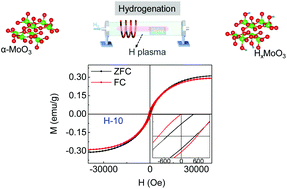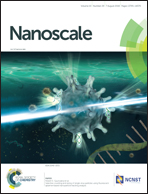Hydrogen atom induced magnetic behaviors in two-dimensional materials: insight on origination in the model of α-MoO3†
Abstract
Atomic layered two-dimensional (2D) materials have become fascinating research topics due to their intriguing performances, but the limitation of nonmagnetic properties hinders their further applications. Developing versatile strategies endowing 2D materials with ferromagnetism is one of the main trends in current research studies. Herein, a hydrogen plasma strategy is introduced to dope hydrogen (H) atoms into the prototypical layered α-MoO3 nanosheets, by which ferromagnetic and exchange bias (EB) effects can be induced by H atom doping into α-MoO3 to form HxMoO3. These effects were interpreted by density functional theory (DFT) calculations. We find that H atom doping can introduce unoccupied states and induce a net magnetic moment localized on the d orbital of the Mo atom, because of the generated asymmetric distribution of electronic states on the Mo atom near the Fermi level. Moreover, the saturation magnetization and the EB field (He) of hydrogenated α-MoO3 are found to be tunable through altering the amount of H dopant. This work provides new perspectives for the effective manipulation of ferromagnetism and exchange interaction through H doping. We hope that the presented hydrogenation strategy is applicable for other kinds of 2D materials.



 Please wait while we load your content...
Please wait while we load your content...